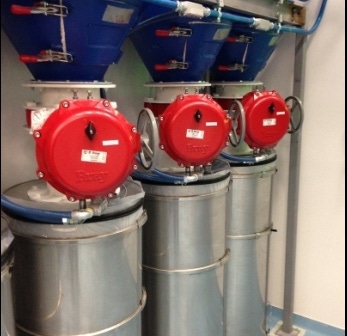Ground Plate Collector Helps Keep Pharmaceutical Company's Process in Check with FDA
January 16, 2014

Aerodyne Environmental, a leading manufacturer of industrial cyclonic dust collectors and dust collection valves, recently assisted with a prominent U.S. pharmaceutical company’s application.
The company was creating a dust collection system for the facility where a variety of drugs are manufactured. The company plans on using a cartridge collector as part of the pill manufacturing process. Because it is regulated by the FDA, every gram of product must be accounted for, even the dust. The pill dust that is created is extremely fine and flows like water. The cartridge collector would only be able to collect some of the particulate in the process, most of which would get stuck in the filters and would be hard to account for. Additionally, the facility uses a bag-in/bag-out process with its cartridge collectors. This means that when the cartridges or collection tanks that are filled with dust are changed out, bags are used so that no dust is released. Again, because every gram of dust produced during operation must be accounted for, using the bag-in/bag-out method will help ensure that none of the particulate gets lost.
The company was still looking for a way to collect all of the particulate before going through the cartridge collectors, and reached out to Aerodyne for assistance. After going over the proposed dust collection set up the facility had in place, Aerodyne suggested the company use the Ground Plate Collector (GPC) to collect the fine dust. The GPC is a compact, high-efficiency cyclone dust collector. It has several distinct advantages over common high-efficiency cyclone dust collectors. The spiral inlet of the GPC directs the dirty gas stream toward the ground plate and hopper of the collector. Coupled with the compact size of the collectors, this gives the GPC the ability to be installed horizontally with virtually no effect on the collection efficiency.
The company purchased 15 vertical Class 1, carbon steel GPC-20s for its plant. The GPCs are in rows of five, and each row is located in its own "clean room". Each clean room serves a different purpose, such as pill coating, encapsulation, etc. The GPCs are fitted with a special bag for the bag-in/bag-out process to further prevent dust loss. The rows of cyclones then feed a cartridge collector for final dust collection. After roughly 16 hours of operation, almost zero dust reached the cartridge collector.
Placing the GPCs in front of the cartridge collectors has provided numerous benefits to this process. Because the dust passes through the GPCs before the cartridge collectors, the filter life gets extended. Filters need to be replaced frequently because they fill up with product in a short amount of time. However, by placing a cyclone before the cartridge collector in the process, less product reaches the filter so they don't have to be replaced as often. This also helps with overall recovery of the product, which is crucial in an application such as this where there are FDA regulations and all of the dust must be accounted for. Additionally, the GPC is more low maintenance than cartridge collectors. By sending the bulk of the application into the dust collector before the cartridge filter helps maintenance time and costs are drastically reduced.
For more information, call 800-358-7546, e-mail [email protected], or visit www.dustcollectorhq.com.
For related equipment reviews, articles, and news, visit our Dust Collection & Air Pollution Control Equipment Zone
Click here for information about International Powder & Bulk Solids Conference & Exhibition
You May Also Like


